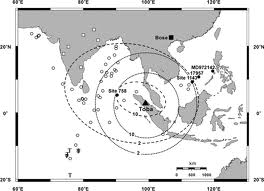The Toba super-volcano eruption took place 74,000 years ago and wiped out humanity over a large region of SE Asia – but there were some survivors. The traditional, single, out-of-Africa narrative puts the expansion wave beginning after the Toba eruption. My preferred narrative is of multiple waves out of Africa and into Arabia long before the Toba eruption and the main post-Toba expansion being from Africarabia. This narrative then includes admixture and assimilation of survivors from pre-Toba waves of expansion who were found along the way. Peoples from pre-Toba expansions who had settled in SE Asia would probably not have survived the eruption. Some of the pre-Toba peoples survived in isolated areas of India and points west and were mainly assimilated by later post-Toba waves.

Toba fallout: from geology.gsapubs.org
The theory has been that it was post-Toba waves of humans which reached Australia around 40,000 years ago at the earliest. But evidence is emerging that humans were in Austalia at least 65,000 years ago. Distinctive stone tool assemblages including grinding stones, ground ochres, reflective additives and ground-edge hatchet heads have been found in Madjedbebe, a rock shelter in northern Australia and dated to 65,000 years ago (stratigraphic and optical dating).
That would suggest that the first human Australians came either directly from a pre-Toba expansion or post-Toba from peoples in SE Asia who had themselves oioginated from a pre-Toba expansion.
Clarkson, et al, Human occupation of northern Australia by 65,000 years ago, Nature 547, 306–310 (20 July 2017), doi:10.1038/nature22968
Abstract: The time of arrival of people in Australia is an unresolved question. It is relevant to debates about when modern humans first dispersed out of Africa and when their descendants incorporated genetic material from Neanderthals, Denisovans and possibly other hominins. Humans have also been implicated in the extinction of Australia’s megafauna. Here we report the results of new excavations conducted at Madjedbebe, a rock shelter in northern Australia. Artefacts in primary depositional context are concentrated in three dense bands, with the stratigraphic integrity of the deposit demonstrated by artefact refits and by optical dating and other analyses of the sediments. Human occupation began around 65,000 years ago, with a distinctive stone tool assemblage including grinding stones, ground ochres, reflective additives and ground-edge hatchet heads. This evidence sets a new minimum age for the arrival of humans in Australia, the dispersal of modern humans out of Africa, and the subsequent interactions of modern humans with Neanderthals and Denisovans.
My preferred narrative has at least three waves leaving Africarabia, starting perhaps around 120,000 years ago.


My understanding is that some of earliest cultural artifacts of modern human are found in Blombos Cave in South Africa and date to around 100,000 years ago. Wouldn’t we expect to find something older than 120,000 years if modern humans left Africa to reach Australia at that time.
Maybe humans reached Arabia – in many waves – 110,000+ years ago. Then how far they spread East before Toba erupted 74,000 years ago is uncertain. Those who reached Australia 65,000 years ago could be from a pre-Toba wave or – more likely – a post-Toba expansion but from S Asia rather than Africa. Just speculation of course.
Yes, but still we would expect artifacts in Arabia from 110,000+.
Of course, the artifacts might eventually be found. Maybe they are underwater even humans primarily stayed on the coasts.
Jeffrey Rose’s work in Saudi Arabia has found tools apparently of the right age. “A study of stone tools from Arabia, northeastern Africa, and the Middle East by Jeffrey Rose of the Ronin Institute, and Anthony Marks of Southern Methodist University, begins with the evolution of stone tools from the Nile Valley some 150,000 to 130,000 years ago”.
See: http://www.archaeology.org/news/3040-150225-arabia-emiran-tools
http://www.springer.com/gp/book/9789048127184
I am also quite sure that the humans followed the coast eastwards and there are sites now surely underwater around Arabia and what is now the Persian Gulf and all the way down to Kutch.